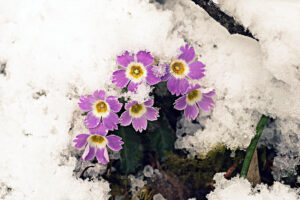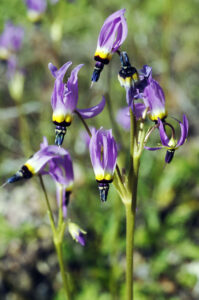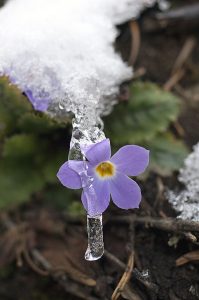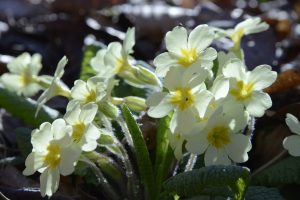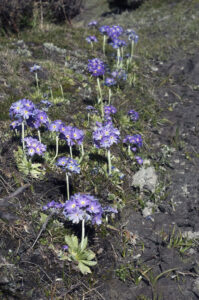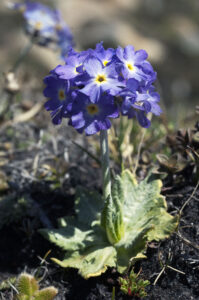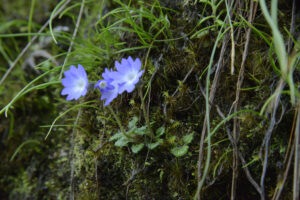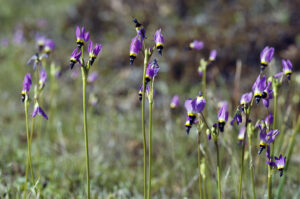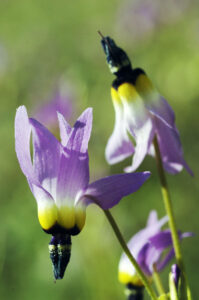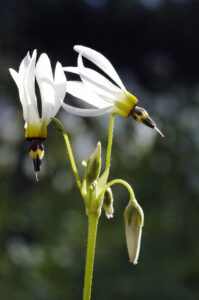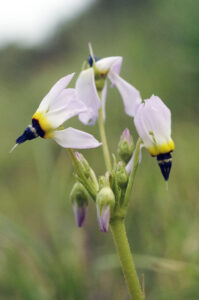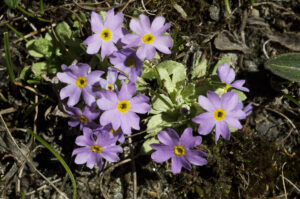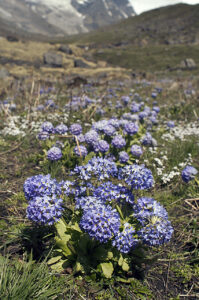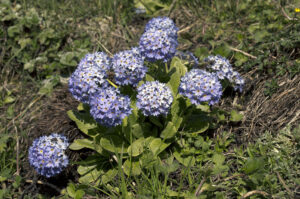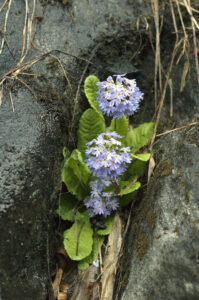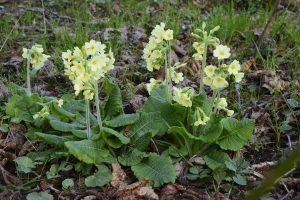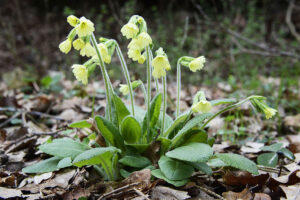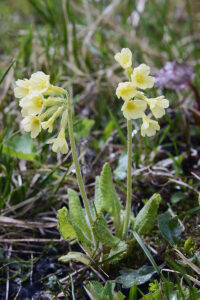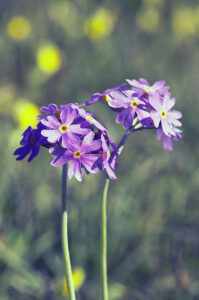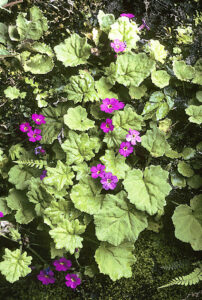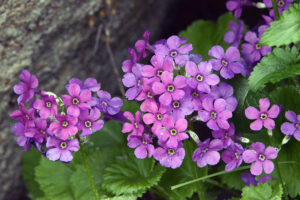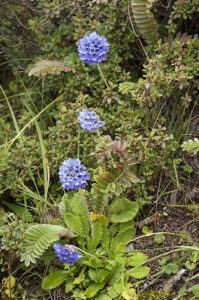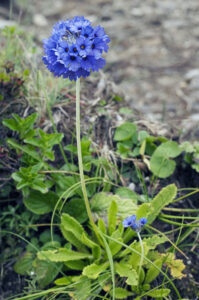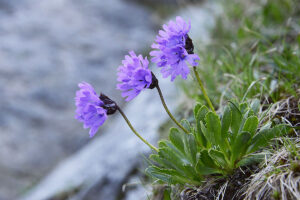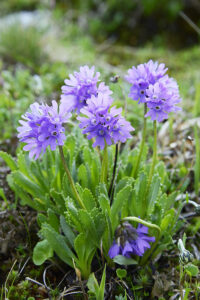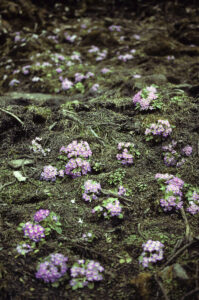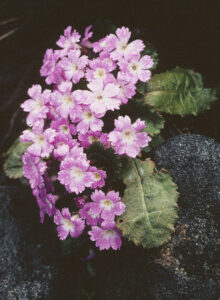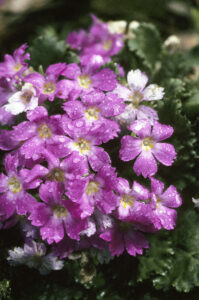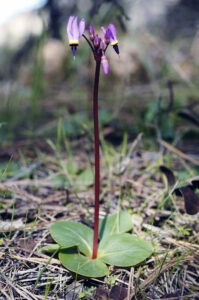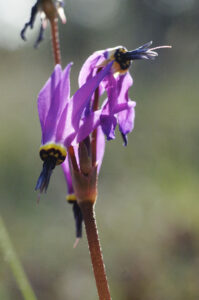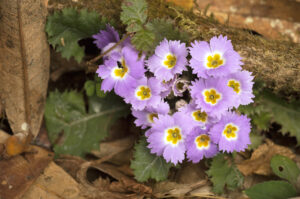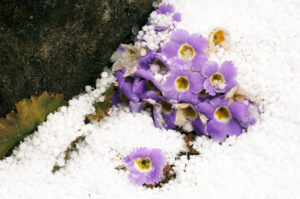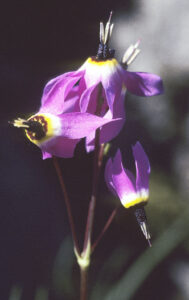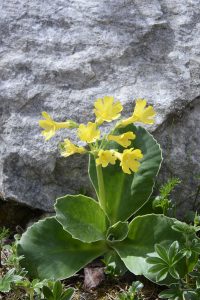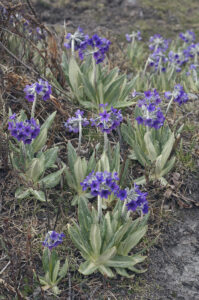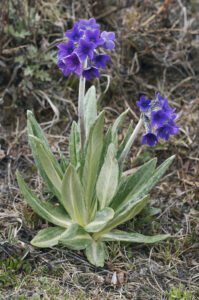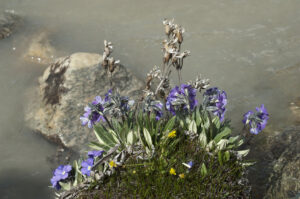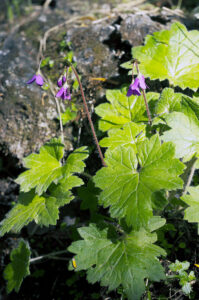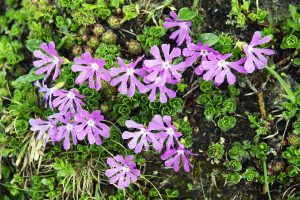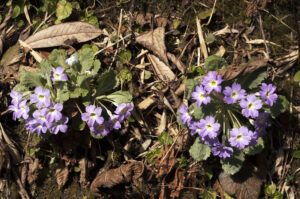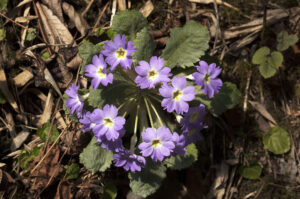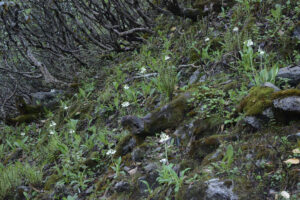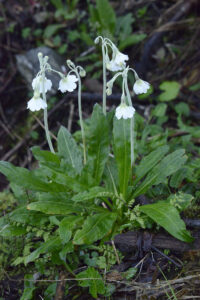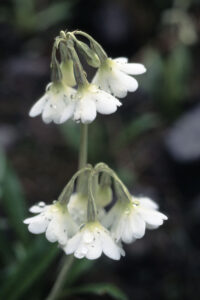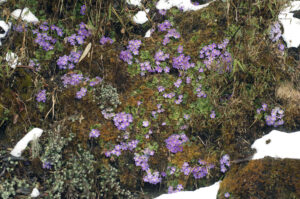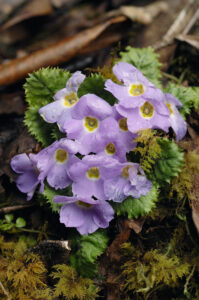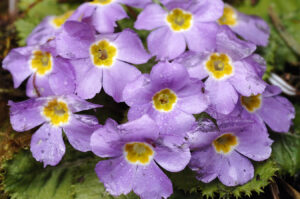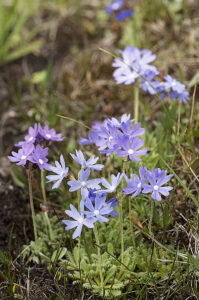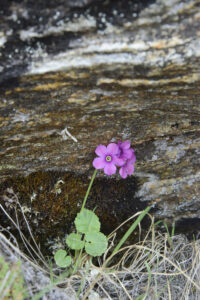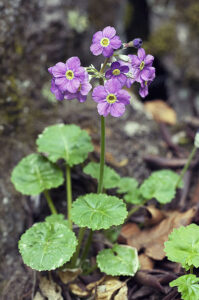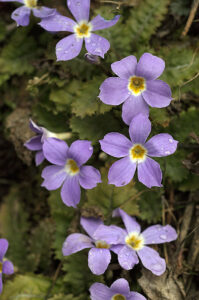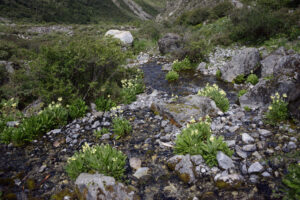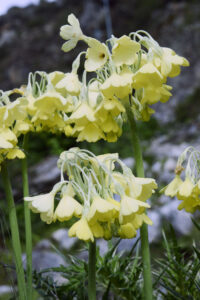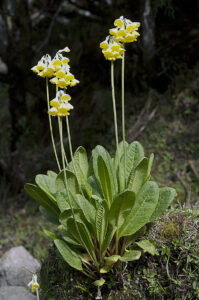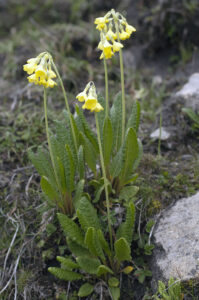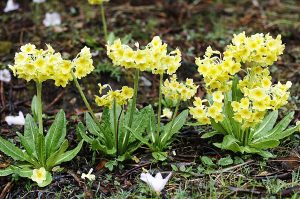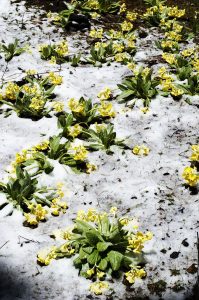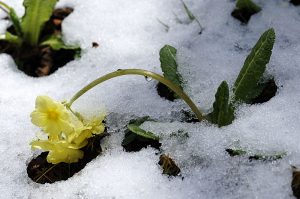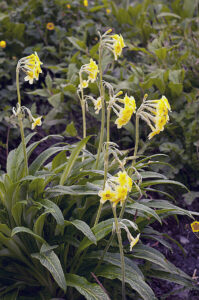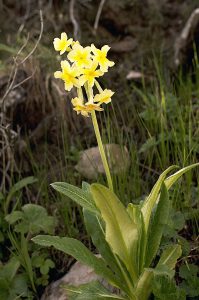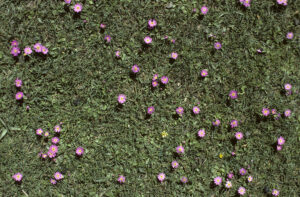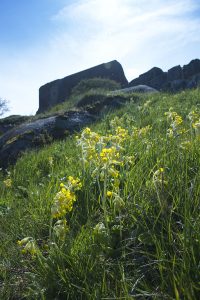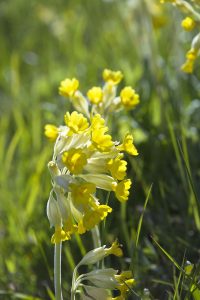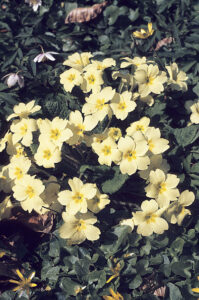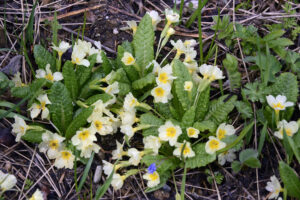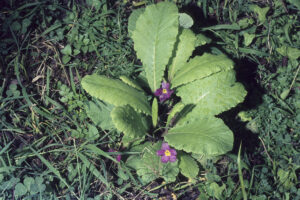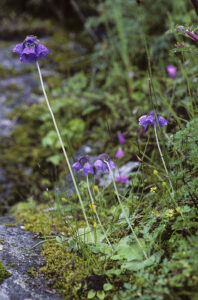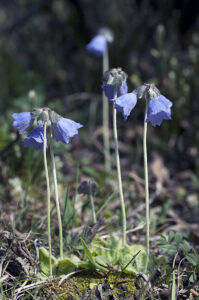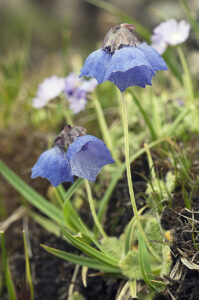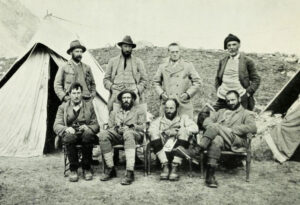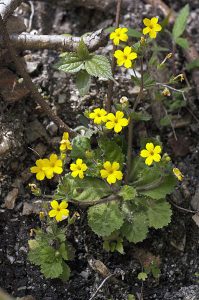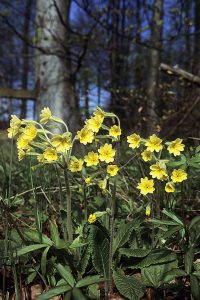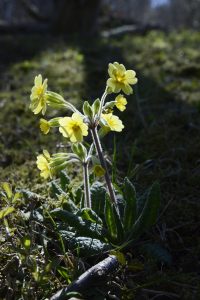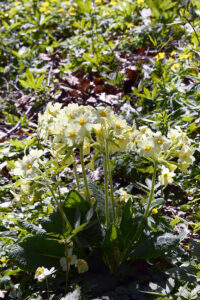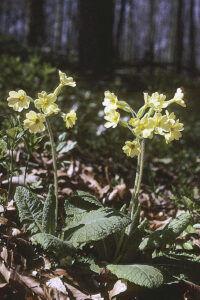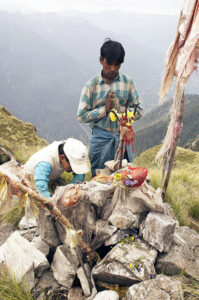Primroses
Snow, falling the previous night, has partly buried these Primula irregularis flowers, growing near Tharepati, Helambu, central Nepal. (Photo copyright © by Kaj Halberg)
Shooting stars, comprising 17 species, are a group of primroses, which were formerly placed in the genus Dodecatheon. These plants are widespread in western North America. The picture shows Padre’s shooting star (Primula clevelandii), found from central California southwards to northern Baja California. (Photo copyright © by Kaj Halberg)
Frozen waterdrop, hanging down from a Primula sessilis flower, Dodi Tal, Asi Ganga Valley, Uttarakhand, northern India. Snow, which fell on the plant the previous evening, partly melted, but froze again during the night. (Photo copyright © by Kaj Halberg)
English primrose (Primula vulgaris), Møn, Denmark. The flower colour of this species, divided into 3 subspecies, varies from yellow to white, pink, red, or purple. (Photo copyright © by Kaj Halberg)
‘Cow dung’
Primrose, cowslip, oxlip, shooting star – these names all refer to members of the genus Primula. This large genus, comprising about 520 species, is native to temperate areas of the Northern Hemisphere and southern South America, and also to tropical mountains in Ethiopia, Indonesia and New Guinea. A core area is Central Asia, China, and the Himalaya, which is home to almost half of the species.
The generic name is a diminutive of the Latin prima (’first’), referring to the early flowering of several species. Many of these plants are indeed very hardy, as seen in two of the pictures above.
The name primrose is from the Latin prima rosa, meaning ‘the first rose’, although primroses are not at all related to roses.
According to some authorities, the name cowslip is a corruption of an Old English word, cuslyppe, meaning ‘cow dung’. This probably refers to the favoured habitat of the common cowslip (P. veris), namely dry slopes, grazed by cattle. Others claim that the word is a corruption of cow’s leek, derived from the Anglo-Saxon word leac, meaning ‘plant’.
It has been said that the name oxlip, which is a corruption of ox and slip, refers to the fact that oxlip, like cowslip, often grows on cattle grazing grounds. This may be a wrong presumption, as true oxlip (P. elatior) – at least in the northern part of its distribution area – mainly grows in forests.
Primula atrodentata
A small plant, leaves forming a rosette, stalkless or short-stalked, blade elliptic, oblong, or spatulate, to 6 cm long and 2 cm wide, with dense white or yellow farina beneath, margin toothed, tip blunt. Inflorescence stems to 10 cm tall, elonging in fruit, umbel forming a dense head of numerous stalkless flowers. Calyx bell-shaped, to 7 mm long, lobes lanceolate, tipped dark-brown or black. Corolla lavender or pale blue-violet, with a white eye, fragrant, to 2 cm across, tube to 1.4 cm long, lobes broadly obovate.
It grows in open areas at altitudes between 3,500 and 4,900 m, distributed from Uttarakhand eastwards to south-eastern Tibet.
The specific name is Latin, meaning ‘with black teeth’, alluding to the black-tipped calyx-lobes.
P. denticulata (below) is quite similar, but much larger, and it lacks the dark-tipped calyx-lobes.
Primula atrodentata, between Dingboche and Dusum, Khumbu, eastern Nepal. (Photos copyright © by Kaj Halberg)
Primula cf. buryana
By Kew Gardens, the primrose in the pictures below is regarded as a variety, purpurea, of P. buryana. However, this plant is quite different from P. buryana, having pale blue or pale lilac flowers with white around the throat, whereas P. buryana has pure white flowers and a higher number of flowers in the inflorescence.
Furthermore, P. buryana is found in drier areas along the Tibetan border, from western to eastern Nepal, and also in Tibet, at elevations between 3,300 and 5,000 m, whereas the blue-flowered plant is restricted to central Nepal, mainly growing on rock-ledges at altitudes between 2,900 and 4,600 m, fully exposed to the monsoon rains.
I am convinced that the latter is a distinct species, as also suggested by Polunin and Stainton in their book Flowers of the Himalaya (1984).
The blue-flowered plant has slender, hairy stems, to 18 cm tall, leaves in a basal rosette, ovate to oblong-ovate, densely hairy on both surfaces, and with long white hairs along the margin, blade tapering into a winged stalk, both to 2.5 cm long. Flowers single or up to 3 together, broadly funnel-shaped, to 2 cm across, very short-stalked, pale blue or pale lilac with white around the throat, calyx with shaggy white hairs.
The discovery of P. buryana is related below, see P. wollastonii.
Primula cf. buryana, Phedi, near Gosainkund, Langtang National Park, central Nepal. (Photos copyright © by Kaj Halberg)
Primula clevelandii Padre’s shooting star
This plant is native from central California southwards to northern Baja California, growing in grassy areas. Leaves are basal, to 16 cm long, the flower stems up to 30 cm tall, with nodding, magenta, deep lavender, or white flowers, to about 2.5 cm long.
The specific name honours San Diego-based lawyer, politician, and botanist Daniel Cleveland (1838-1929), who was the first to carry out a systematic study of the plants of the San Diego area. He found many species new to science.
Padre’s shooting star belongs to a group of primroses, which were formerly placed in the genus Dodecatheon, erected by Swedish botanist Carl Linnaeus (1707-1778), supposedly because the inflorescence of these plants often consists of 12 flowers. The name stems from Ancient Greek dodeka (’twelve’) and theos (’god’), thus ‘twelve gods’. The Ancients applied this name to plants that they thought had acquired their medicinal properties from the twelve most prominent gods and goddesses.
This group, comprising 17 species, is widespread in North America, from north-western Mexico northwards through western United States and Canada to Alaska, with a single species extending into north-eastern Siberia. The flowers are pollinated by bees, which cling to the corolla by beating their wings very fast, thus releasing the pollen.
The popular name shooting star refers to the flowers, in which the yellow stamens and the corolla lobes, which are bent backwards, converge to a common point, likened to a shooting star, in which the lobes constitute the ‘tail’.
Other members of the group include Jeffrey’s shooting star (P. jeffreyi) and Henderson’s shooting star (P. hendersonii), both presented below.
Padre’s shooting star, normal-coloured form, Pinnacles National Park, California. (Photos copyright © by Kaj Halberg)
White form, Ronald W. Caspers Wilderness Park, Santa Ana Mountains, California. (Photos copyright © by Kaj Halberg)
Intermediate, pinkish form, Point Mugu State Park, California. (Photo copyright © by Kaj Halberg)
Primula concinna
A tiny plant with yellow farina, leaves usually stalkless, forming a rosette, blade oblanceolate or spatulate, to 2.5 cm long and 6 mm wide, margin mostly entire, with blunt teeth towards the tip, which is pointed or blunt. Inflorescence stalk less than 1 cm long, sometimes absent, umbel with 2-6 flowers, corolla to 1 cm across, pink, mauve, or white with a yellow eye, lobes obovate, deeply notched.
It is distributed from western Nepal eastwards to Bhutan and south-eastern Tibet, found at elevations between 4,000 and 5,200 m.
The specific name is a shortened form of the Latin concinnatus (‘harmonic’).
Primula concinna, Gokyo Valley, Khumbu, eastern Nepal. (Photo copyright © by Kaj Halberg)
Primula denticulata
This very variable plant is the most abundant primrose in the Himalaya, growing in a variety of habitats, including forest clearings, shrubberies, and grasslands. It has a broad altitudinal range, found at elevations between 1,300 and 4,900 m, from Afghanistan eastwards to northern Myanmar and south-eastern Tibet.
The leaves, which form a rosette, have a winged stalk, usually short, but occasionally to 15 cm long, blade oblong to oblanceolate, to 20 cm long and 4 cm broad, sometimes with white or yellow farina, margin toothed, tip blunt. The leaves become longer in fruit, to 30 cm. Inflorescence stems of very variable length, to 15 cm long, sometimes with farina on the upper half. Umbel globular, compact, many-flowered, bracts numerous, to 1 cm long, stalks very short. Corolla to 2 cm across, pale blue, pinkish-blue, or purplish, rarely white, with a yellow eye, tube bell-shaped, to 2 cm long, lobes obovate, to 8 mm long, deeply bi-lobed. As a rule, the inflorescences become larger and denser with higher altitude.
The specific name is Latin, meaning ‘with small teeth’, alluding to the leaves.
P. glomerata (below) also has globular umbels, but has a much longer inflorescence stalk, and the head is more compact.
Primula denticulata is abundant around Annapurna Base Camp, central Nepal, where these pictures were taken. (Photos copyright © by Kaj Halberg)
Primula denticulata, growing in a crack between two rocks, Doban, Modi Khola Valley, Annapurna. (Photo copyright © by Kaj Halberg)
Primula elatior True oxlip
Leaves are in a rosette, wrinkled, hairy on both sides, to 20 cm long and 6 cm broad, narrowing towards the base into a winged stalk, margin down-rolled, irregularly toothed. The inflorescence is an umbel-like cluster of 10-30 flowers, often one-sided, at the end of a stalk, to 30 cm long, corolla to 1.5 cm across, pale yellow with darker yellow throat.
True oxlip is distributed in the major part of Europe, northwards to Denmark and southern Sweden, and in northern Asia, eastwards to the Altai Mountains, southwards to the Caucasus, Turkey, and northern Iran. It grows in forests and damp grasslands, and along streams.
The specific name is Latin, meaning ‘taller’ (than the common P. veris).
True oxlip, Funen, Denmark. (Photos copyright © by Kaj Halberg)
In the Alps, ssp. intricata grows in open areas at altitudes up to about 2,500 m, here observed at Hochtor, near Grossglockner, Austria. (Photo copyright © by Kaj Halberg)
Primula farinosa Birdseye primrose
Leaves numerous, stalked, forming a dense rosette, stalk to 6 cm long, but often much shorter, blade oblong, obovate, or oblong-lanceolate, to 7 cm long and 4 cm wide, often with farina, margin with few teeth or almost entire, tip blunt. Flower stalk to 20 cm tall, but often very short, usually with farina near the tip, umbels many-flowered, bracts to 8 mm long, flowers with varying stalks, from 3 mm to 1.5 cm, to 2.5 cm in fruit. Calyx bell-shaped, to 6 mm long, 5-ribbed, with hairy, triangular lobes. Corolla to 1 cm across, lilac or purple, tube to 8 mm long, lobes obovate, notched.
This fine little plant has a very wide distribution, from Scotland and Scandinavia eastwards to Kamchatka, in Asia southwards to Kyrgyzstan and northern China, with isolated populations in the mountains of central and southern Europe.
The specific name is derived from the Latin farina (‘flour’), alluding to the fine grains on the stem and sometimes on the leaves.
Birdseye primrose often forms large populations, as in this picture from a littoral meadow on the island of Bornholm, Denmark. The blue flowers are common butterwort (Pinguicula vulgaris). (Photo copyright © by Kaj Halberg)
Birdseye primrose, Bornholm, Denmark. (Photo copyright © by Kaj Halberg)
Primula geraniifolia
Leaves basal, forming a loose rosette, occasionally producing stolons in leaf axils, stalk to 13 cm long, hairy, blade variable, rounded, to 8 cm across, base heart-shaped, palmately lobed, lobes 7-9, sometimes very shallow (as in pictures below), margin sharply toothed, tip pointed. Inflorescence stalks to 30 cm tall, densely hairy, umbels with 3-12 flowers, individual flowers short-stalked, calyx bell-shaped, to 1 cm long, parted to the middle, lobes lanceolate, veined, corolla rose-coloured, dark red, or purple, to 2 cm across, tube to 1.3 cm long, lobes obovate, to 8 mm long and 5 mm wide, more or less deeply notched.
It mainly grows on wet banks in forests at altitudes between 2,700 and 4,600 m, from central Nepal eastwards to south-western China.
As its specific name implies, the leaves of this plant resemble those of certain species of crane’s-bill (Geranium).
Primula geraniifolia, Gorjegaon, near Dobhan, Tamur River, eastern Nepal. (Photo copyright © by Kaj Halberg)
Primula geraniifolia, below Langtang Lirung, Langtang National Park, central Nepal. (Photo copyright © by Kaj Halberg)
Primula glomerata
This species is easily identified by the inflorescence, which is a very dense globular head. The inflorescence stem is much longer than that of P. denticulata, which also often has globular flower-heads. It is one of the few primroses blooming in autumn.
Leaves basal, forming a rosette, stalk winged, to 4 cm long, blade oblong, oblanceolate, or spatulate, to 15 cm long and 3 cm broad including stalk, margin sharply and irregularly toothed, tip rounded. Inflorescence stalk to 30 cm long, farinose or glandular-hairy above, umbel a globular head, to 5 cm in diameter, corolla sky-blue with a dark throat, to 1 cm across, tube funnel-shaped, to 1.5 cm long, lobes spreading, obovate, deeply notched.
It is distributed from western Nepal eastwards to south-eastern Tibet, at altitudes between 3,000 and 5,700 m.
The specific name is Latin, meaning ‘having been made into a ball’, ultimately from glomero (‘to gather’).
Primula glomerata, Dukpu, near Ganja La, Langtang National Park, central Nepal. In the upper picture, leaves of a cinquefoil, Potentilla peduncularis, and a dwarf rhododendron, are also seen. (Photos copyright © by Kaj Halberg)
Primula glutinosa Sticky primrose
This plant, usually below 10 cm tall, has fleshy, stiff, upright, toothed, glandular-hairy, sticky leaves, to 6 cm long and 1 cm broad. The inflorescence is a dense umbel at the end of a stalk to 9 cm long, corolla funnel-shaped, to 1.5 cm across, blue, bluish-violet, or reddish-violet with a white throat, surrounded by a bluish-purple ring, lobes deeply cleft. The sepals are covered by conspicuous dark bracts, to 1.1 cm long.
It grows in alpine grasslands and areas of snowmelt on acidic soils, at elevations between 2,000 and 3,200 m. It is distributed in the central and eastern Alps, and in the northern part of the Balkan Peninsula.
It forms a confusing variety of hybrids with P. minima (below).
The specific name is from the Latin gluten (‘glue’), alluding to the sticky glands on the leaves.
Sticky primrose, Stubach Valley, Hohe Tauern, Austria. (Photos copyright © by Kaj Halberg)
Primula gracilipes
This species has no inflorescence stalk, the flowers sprouting individually directly from the leaf rosette. Leaves short-stalked or stalkless, blade elliptic or oblong-spatulate, to 7 cm long and 3.5 cm broad, sometimes farinose beneath, margin irregularly toothed, tip rounded. Flowers numerous, stalk to 6 cm long, glandular-hairy, erect or drooping. Calyx bell-shaped, to 9 mm long, yellowish farinose or glandular, cleft to the middle. Corolla to 4 cm across, bright purplish-pink with an orange-yellow, star-shaped eye, surrounded by an irregular white border, tube to 1.3 cm long, lobes broadly obovate, usually with 3 large teeth.
It occurs from central Nepal eastwards to Bhutan and south-eastern Tibet, growing at elevations between 2,700 and 4,100 m.
The specific name is derived from the Latin gracilis (‘slender’) and pes (‘foot’). What it refers to is not clear.
Primula gracilipes, between Mumbuk and Shunin Oral, Makalu-Barun National Park, eastern Nepal. (Photos copyright © by Kaj Halberg)
Primula hendersonii Henderson’s shooting star
This species, also called broad-leaved shooting star, is native from southern British Columbia and Idaho southwards to southern California. It usually grows in open woodlands, from sea level in British Columbia to an altitude of about 1,900 m in California. Leaves are basal, rounded, to 16 cm long, inflorescence stem to 30 cm long, with nodding, magenta, deep lavender, or white flowers, to 2.5 cm long.
Shooting stars in general are discussed above, see P. clevelandii.
Henderson’s shooting star, Cache Creek Wilderness Area, California. (Photos copyright © by Kaj Halberg)
Primula integrifolia Entire-leaved primrose
As its name implies, the leaves of this dwarf plant, rarely exceeding a height of 5 cm, are entire. They are short-stalked, ovate or lanceolate, fleshy, smooth, and sticky, to 4 cm long and 1.5 cm wide, tip rounded or pointed, margin glandular-hairy. Inflorescence only with a single or 2 flowers, stalk to 3.5 cm long, corolla to 2.5 cm across, reddish-lilac or pinkish-purple, lobes deeply cleft, throat sometimes whitish, glandular-hairy.
It is distributed from Austria westwards to the French Alps and the Pyrenees, growing on acid soils, mainly along streams and in snow-melt areas, at elevations between 1,100 and 3,100 m.
Entire-leaved primrose, Rinnbach, Pongau, Austria. (Photo copyright © by Kaj Halberg)
Primula irregularis
This pretty plant has no inflorescence stalk, the flowers sprouting individually directly from the leaf rosette. Leaves of 2 kinds, some long-stalked, others almost stalkless, blade oblong or elliptic, toothed, initially with yellow farina, to 12 cm long and 3 cm wide at flowering, enlarging in fruit. Flowers very short-stalked, to 3.2 cm across, bright pink, rarely pale violet, with an orange-yellow star-shaped eye, surrounded by a broad white border, lobes very ragged-toothed. Calyx and flower-stalks have stalked glands.
It occurs from western Nepal eastwards to Sikkim, growing at altitudes between 2,500 and 3,700 m.
The specific name presumably refers to the ragged-toothed corolla lobes.
In this picture, Primula irregularis grows among withered leaves of Rhododendron arboreum, photographed early in spring at Magingoth, Langtang National Park, central Nepal. (Photo copyright © by Kaj Halberg)
Snow, falling the previous night, has partly buried these Primula irregularis flowers, observed between Magingoth and Tharepati. (Photos copyright © by Kaj Halberg)
Primula jeffreyi Jeffrey’s shooting star
This species, previously named Dodecatheon jeffreyi, is distributed from Alaska and Montana southwards to California, growing in mountain meadows and along streams.
The Nlaka’pamux people used the flowers as amulets and love charms.
It was named in honour of Scottish botanist John Jeffrey (1826-1854), who spent four years exploring and collecting plants in Washington, Oregon, and California, sending his specimens back to Scotland. In 1854, he disappeared while travelling from San Diego across the Colorado Desert, and was never seen again.
An alternative name of this plant is Sierra shooting star, alluding to the Sierra Mountains of California.
Shooting stars in general are discussed above, see P. clevelandii.
Jeffrey’s shooting star, Yosemite National Park, California. (Photos copyright © by Kaj Halberg)
Primula lutea Yellow mountain cowslip
Previously, it was presumed that the mountain cowslip (P. auricula) was distributed in the major part of the central European mountains, including the Alps, the Apennines, the Juras, the Vosges, the Black Forest, the Tatras, the Carpathians, and the Balkan mountains. However, recent genetic studies have split it into two separate species, the western P. auricula, and the eastern and southern P. lutea, by some authorities named P. balbisii.
Collectively, these plants are known as bear’s ear, alluding to the shape of the leaves. They are the source of a huge number of primrose cultivars.
Yellow mountain cowslip is easily identified by the bright yellow flowers and the dull-green, broadly obovate, thin leaves, strongly serrated along the margin, and covered in glandular hairs. The leaf blade of P. auricula is usually narrower, almost lanceolate.
Yellow mountain cowslip, Trenta Valley, Triglavski National Park, Slovenia. The small plant is alpine lady’s mantle (Alchemilla alpina). (Photo copyright © by Kaj Halberg)
Primula macrophylla
A robust, very variable plant, farinose all over, except corolla and upper leaf surface. Leaves mostly erect, lanceolate or strap-shaped, to 30 cm long and 4.5 cm wide, base wedge-shaped, tapering into a winged stalk, margin entire, sometimes toothed, tip pointed. Inflorescence stems to 30 cm tall, umbels rather lax, with 5-25 flowers, often drooping, bracts lanceolate, to 3.5 cm long, calyx cylindrical, with linear lobes, corolla violet, purple, or lilac, with a darker eye, tube to 3 cm long, lobes elliptic or obovate, to 6 mm long.
This species is distributed from Kyrgyzstan and Xinjiang southwards across Tibet to northern Pakistan, and thence eastwards to Bhutan, growing at elevations between 3,300 and 5,600 m. It is very common in the Khumbu area, eastern Nepal.
The specific name is derived from Ancient Greek makros (‘long’) and phyllon (‘leaf’).
Primula macrophylla, Chhukung, Khumbu, eastern Nepal. (Photos copyright © by Kaj Halberg)
Primula macrophylla, growing at the edge of a pond, Machhermo, Gokyo Valley, Khumbu. (Photo copyright © by Kaj Halberg)
Primula matthioli ssp. brotheri
This plant was previously regarded as a separate species, called Cortusa brotheri, but has now been moved to the genus Primula and reduced to a subspecies.
Leaves long-stalked, hairy, blade rounded, to 10 cm long and broad, with 5-7 shallow lobes, strongly toothed, base heart-shaped. Inflorescence stalk to 23 cm long, slender, umbel with 3-12 drooping flowers, calyx bell-shaped, to 5.5 mm long, with 5 triangular lobes, corolla bell-shaped, rosy-purple, to 1.5 cm long and 2.5 cm across, deeply cleft below the middle into 5 oblong lobes with entire margin, sometimes notched.
This subspecies is found from Kazakhstan and Mongolia southwards to northern Pakistan, Himachal Pradesh, and Uttarakhand. In the Himalaya, it grows at elevations between 3,000 and 4,200 m. The species, in its widest sense, is distributed from northern Siberia southwards to the Himalaya, northern China, Korea, and Japan, and it also occurs in montane areas of central Europe and the Balkans.
The specific name honours Italian physician and naturalist Pietro Andrea Gregorio Mattioli (1501-1577), personal physician of Emperor Maximilian II (1527-1576). He described more than a hundred new plants, and in his work Discorsi, he made famous comments on De Materia Medica, written by Greek physician, pharmacologist, and botanist Pedanius Dioscorides (died 90 A.D.). In 1561, he published a work on medicinal plants, Epistolarum Medicinalium Libri Quinque.
The obsolete generic name Cortusa was applied by Mattioli in honour of Giacomo Antonio Cortusi (1513-1603), who presented the plant to him, found north of Vicenza. From 1590, he was the director of the botanical garden in Padova,
Primula matthioli ssp. brotheri, Ghumtarao, Great Himalayan National Park, Himachal Pradesh. (Photo copyright © by Kaj Halberg)
Primula minima Least primrose
This mat-forming plant is easily identified by the large corolla, to 3 cm across, bright pink with a white throat, lobes deeply cleft, V-shaped. At flowering time, the leaves are usually inconspicuous, rolled-up into ‘balls’, later becoming wedge-shaped, to 3 cm long and 1 cm wide, shining, strongly toothed at the tip.
It is quite common in the eastern half of the Alps, and also in the Tatras, the Carpathians, and the northern Balkans, eastwards to Ukraine, growing in scree and snowmelts, usually on acid soils, at altitudes between 1,200 and 3,000 m.
Least primrose, near Grossglockner, Austria. (Photos copyright © by Kaj Halberg)
Primula miyabeana
This species is native to humid forests in central Taiwan, growing at elevations between 2,500 and 3,500 m. However, it is a popular garden plant in the island, often making it difficult to determine whether a population is genuinely wild or not.
The leaves, which form a rosette, are to 20 cm long and 5 cm wide, wrinkled and sharply toothed. The inflorescence stem is to 45 cm tall, with 2-4 superimposed umbels, each with 6-10 purple flowers.
Primula miyabeana, Alishan National Forest, Taiwan. (Photo copyright © by Kaj Halberg)
Primula nana
The flowers of this species, formerly named P. edgeworthii, sprout individually directly from the leaf rosette, leaves bluish- or greyish-green, spatulate, to 5 cm long at flowering, longer in fruit, entire at first, later toothed, farinose on both sides when young. Flowers on individual stalks to 4 cm long, but longer in fruit, with farina, corolla to 3 cm across, pale violet or blue, rarely pink or white, with a greenish-yellow, star-shaped eye, surrounded by a narrow, irregular, white border, lobes variable, usually with 3 lobes, of which the middle one is much smaller and pointed, but lobes may also be entire or toothed.
It is distributed from Himachal Pradesh eastwards to central Nepal, growing at elevations between 2,100 and 4,100 m. It is common in the Annapurna area, central Nepal.
The specific name is derived from Ancient Greek nanos (‘dwarf’), alluding to its growth form. The obsolete specific name honours Irish botanist Michael Pakenham Edgeworth (1812-1881), who spent many years in India, where he collected a large number of plants.
Primula nana, Deorali, near Ghorepani, Annapurna, central Nepal. (Photos copyright © by Kaj Halberg)
Primula obliqua
Leaves in a rosette, with a winged stalk, blade lanceolate, oblanceolate, narrowly obovate, to 20 cm long and 4.5 cm wide, with yellow farina beneath, margin with numerous tiny teeth, tip pointed or blunt. Inflorescence stem to 55 cm long, farinose on upper part, umbel with 4-7 stalked, nodding flowers, calyx tubular, yellowish-brown, to 1 cm long, parted to the middle, lobes oblong, tip blunt, corolla bell-shaped, white or pale yellow, sometimes flushed with pink, to 3 cm across, lobes broadly obovate, deeply indented.
This plant is distributed from central Nepal eastwards to Arunachal Pradesh and south-eastern Tibet, growing at altitudes between 3,000 and 4,400 m. It is quite prominent between Tharepati and Phedi, Langtang National Park, central Nepal.
The specific name is Latin, meaning ‘slanting’ or ‘awry’. What it refers to is not clear.
Primula obliqua, Phedi, near Gosainkund, Langtang National Park, central Nepal. In the upper picture, a species of Polystichum fern is also seen, and in the background Rhododendron campanulatum. (Photos copyright © by Kaj Halberg)
Primula obliqua, Gopte, near Gosainkund. (Photo copyright © by Kaj Halberg)
Primula petiolaris
This species has no inflorescence stalk, the flowers sprouting individually directly from the leaf rosette, which is very tight, without farina, blade obovate, with numerous long, irregular, sharp teeth, blade enlarging after flowering and changing shape to ovate, with a long reddish stalk. Flowers almost stalkless, cup-shaped, to 2 cm across, pink with a broad yellow eye, surrounded by a narrow white ring.
It occurs from Uttarakhand eastwards to Sikkim, growing at altitudes between 2,100 and 3,800 m.
It closely resembles P. gracilipes (above), but is smaller, with a tight leaf rosette, and it lacks farina.
The specific name is derived from the Latin petiolus (‘little foot’), thus ‘having a small foot’, presumably alluding to leaves and flowers being very short-stalked.
Primula petiolaris, above Kutumsang, Langtang National Park, central Nepal. (Photos copyright © by Kaj Halberg)
Primula primulina
A tiny plant, easily identified by its flowers, which have a tuft of white hairs in the throat. Leaves all basal, numerous, spatulate or oblanceolate, to 3 cm long and 5 mm broad, including the winged stalk, margin deeply rounded-toothed, tip blunt. Inflorescence stems slender, to 9 cm long, sparsely glandular-hairy, umbels with 2-4 almost stalkless flowers, corolla to 1.2 cm across, pale blue, purple, or violet, rarely white, with a tuft of white hairs in the throat, tube to 4 mm long, lobes obovate, deeply cleft.
This species grows in open areas at altitudes between 3,600 and 5,000 m, from Uttarakhand eastwards to Bhutan and south-eastern Tibet.
Primula primulina, Gokyo Valley, Khumbu, eastern Nepal. (Photo copyright © by Kaj Halberg)
Primula rotundifolia
Leaves form a rosette, stalk to 10 cm long, blade usually almost circular, sometimes broadly ovate, to 7 cm across, with yellow or white farina on the underside, base heart-shaped, margin irregularly toothed, tip pointed on ovate leaves. Inflorescence stem to 30 cm tall, umbels usually solitary, sometimes 2, one above the other, number of flowers vary greatly, between 2 and 16, stalk to 2 cm long, calyx bell-shaped, to 6 mm long, covered in farina, split to near the base, corolla to 2 cm across, pink or pale purplish with a yellow eye, sometimes surrounded by a narrow white ring, lobes rounded or broadly ovate, margin entire or toothed.
This plant is found at elevations between 3,500 and 5,000 m, from western Nepal eastwards to Sikkim and south-eastern Tibet.
The specific name is Latin, meaning ‘with round leaves’.
Primula rotundifolia, Gosainkund, Langtang National Park, central Nepal. (Photo copyright © by Kaj Halberg)
Primula rotundifolia, Phortse Tenga, Khumbu, eastern Nepal. (Photo copyright © by Kaj Halberg)
Primula sessilis
This species has no inflorescence stalk, the flowers sprouting individually directly from the leaf rosette. It may easily be identified by its serrated, strongly wrinkled leaves, and by the rounded corolla lobes, ending abruptly in a single small tooth. Leaves short-stalked, blade usually elliptic, sometimes rounded, to 6 cm long and 4 cm broad, sharply and irregularly toothed, nerves deeply imprinted above. Flowers short-stalked, stalk glandular-hairy, calyx cylindrical, with narrow, keeled lobes, corolla to 2.5 cm across, pale lilac with a pink flush, and with an orange star-shaped eye, surrounded by an irregular white border, lobes abruptly narrowed to a fine tooth.
It is fairly common in forests at elevations between 2,100 and 3,700 m, from Kashmir eastwards to western Nepal.
The specific name is Latin, meaning ‘sitting’, but in botanical context meaning ‘stalkless’, in this case alluding to the flowers.
An abundance of Primula sessilis on a slope, where the snow has recently melted, Dodi Tal, Asi Ganga Valley, Uttarakhand. (Photo copyright © by Kaj Halberg)
Primula sessilis, growing on a slope, where snow is still present, Dodi Tal, Asi Ganga Valley, Uttarakhand, India. (Photo copyright © by Kaj Halberg)
Primula sessilis, Dodi Tal. This species may be identified by the corolla lobes, which have a small, sharp point. (Photo copyright © by Kaj Halberg)
Primula sikkimensis
A beautiful and stately plant, which may grow to 90 cm tall. Leaves form a rosette, blade elliptic or oblong, to 30 cm long and 7 cm broad, tapering to a short, winged stalk, margin finely and sharply toothed, tip rounded, veins prominent beneath. Inflorescence stems very long, to 90 cm, with yellow farina above, umbels usually solitary, sometimes 2, one above the other, with numerous long-stalked, drooping flowers, bracts awl-shaped, to 2 cm long, calyx bell-shaped, to 1 cm long, split to the middle, prominently 5-veined, densely farinose, corolla bright yellow or pale yellow, rarely creamy-white, to 3 cm across, lobes obovate or oblong, entire or shallowly notched.
It is partial to wet meadows, found at elevations between 2,900 and 4,800 m, from western Nepal eastwards to northern Myanmar and south-western China.
The specific name is Latin, meaning ‘found in Sikkim’.
Large growth of Primula sikkimensis along a stream, between Mundo and Kyangjin Gompa, Langtang National Park, central Nepal. The shrubs are Rosa sericea. (Photos copyright © by Kaj Halberg)
Primula sikkimensis, Shomare, Khumbu, eastern Nepal. (Photos copyright © by Kaj Halberg)
Primula strumosa
Leaves all in a basal rosette, stalkless, blade elliptic, oblanceolate, or oblong, to 20 cm long and 2.5 cm broad, sometimes with yellow farina on the underside, margin with numerous small teeth, tip pointed or blunt. Inflorescence stems to 20 cm tall, with yellow farina above, umbels many-flowered, calyx bell-shaped, to 7.5 mm long, densely yellow farinose, split to the middle, corolla to 2.5 cm across, bright yellow with an orange-yellow eye, tube to 1.3 cm long, lobes rounded, with tiny teeth.
It grows in forests and meadows at altitudes between 3,500 and 4,300 m, from western Nepal eastwards to Bhutan and south-eastern Tibet. It is common in Ghunsa Valley, eastern Nepal.
This species hybridizes freely with the purple P. calderiana, sometimes resulting in yellow, white, blue, and purple flowers in a single mixed population.
The specific name is derived from the Latin struma (‘scrofulous tumor’ or ‘swelling’). What it refers to is not clear.
Primula strumosa, between Ghunsa and Kambachen, Ghunsa Valley, eastern Nepal. In the bottom picture, an inflorescence has been bent to the ground by snowfall. (Photos copyright © by Kaj Halberg)
Primula stuartii
Leaves all in a rosette, blade lanceolate or spatulate, to 30 cm long and 4 cm wide, tapering to a broadly winged stalk, yellow farinose beneath, margin sharply toothed, tip pointed. Inflorescence stem to 40 cm tall, umbel many-flowered, often one-sided, all parts covered in yellow farina, flower stalks to 2.5 cm long, flowers drooping, to 3 cm across, calyx tubular, to 1.5 cm long, more or less split into lanceolate lobes, corolla golden-yellow with an orange-yellow eye, lobes rounded, notched or toothed.
This species is distributed from Himachal Pradesh eastwards to Sikkim, growing at altitudes between 3,500 and 4,600 m.
The specific name honours John Stuart, 3rd Earl of Bute (1713-1792), who was a patron of botany.
Primula stuartii is very common in the Great Himalayan National Park, Himachal Pradesh, where these pictures were taken. (Photos copyright © by Kaj Halberg)
Primula tibetica
Often a prostrate plant, with a rosette of smooth, bright green, ovate, elliptic, or spathulate leaves, to 5 cm long and 1 cm wide, with a short, winged stalk, margin entire, tip blunt. Inflorescence stem to 13 cm tall, but usually much lower, flowers short-stalked, solitary or up to 10 in umbels, bracts oblong or lanceolate, to 1 cm long, below lengthened into blunt auricles, calyx tubular, to 5 mm long, parted to the middle into lanceolate lobes, corolla to 1 cm across, rose-coloured, pinkish-purple, or lilac, with a yellow eye, surrounded by a narrow white ring, tube to 7 mm long, lobes broadly obovate, deeply notched.
It is distributed from Uttarakhand eastwards across southern Tibet and northern Himalaya to Bhutan, growing at elevations between 3,000 and 5,000 m.
Primula tibetica, growing in a heavily grazed meadow, near Lhatze, southern Tibet. The yellow flower is a species of buttercup (Ranunculus). (Photo copyright © by Kaj Halberg)
Primula veris Common cowslip
A very common species in large parts of temperate regions of Europe and western Asia. Popular names include key flower, Herb Peter, and Our Lady’s keys, the first two referring to the inflorescence, which resembles a bunch of keys, the emblem of St. Peter. According to legend, St. Peter heard that some people were trying to enter heaven by the back door, instead of the front gates, which were guarded by him. Hurrying towards the back door, he dropped his keys, which took root and became cowslips. German names of this species include Echte Schlüsselblume, meaning ‘true key flower’, and Himmelsschlüssel, meaning ‘keys of heaven’.
In Norse mythology, the flower was dedicated to Freya, called the Key Virgin, a goddess associated with love, beauty, and fertility. When the heathens converted to Christianity, the plant was instead dedicated to Virgin Mary, hence the name Our Lady’s keys.
Common cowslip has been utilized medicinally for hundreds of years. This usage is described on the page Plants: Plants in folklore and poetry.
In A Midsummer Night’s Dream, by William Shakespeare (1564-1616), a mischievous puck, or spirit, Robin Goodfellow, meets a fairy, asking her what she is doing. She says:
And I serve the fairy queen
To dew her orbs upon the green,
The cowslips tall her pensioners be,
In their gold coats spots you see,
Those be rubies, fairy favours,
In those freckles live their saviours,
I must go seek some dewdrops here,
And hang a pearl in every cowslip’s ear.
Modified into today’s English:
I serve the fairy queen,
Adding dew drops to her flowers in the grass.
The tall cowslips are her servants.
In their golden coats you can see spots.
Those are rubies, gifts from the fairies.
Their sweet smell comes from those freckles.
Now I must go to find some dewdrops,
And hang a pearl earring on every cowslip flower.
In these pictures, common cowslip grows on a slope beneath the ruins of Hammershus Castle, Bornholm, Denmark. (Photos copyright © by Kaj Halberg)
Primula vulgaris Common primrose, English primrose
This species, also called P. acaulis, is among the earliest flowering plants of northern Europe, in mild springs blooming as early as the beginning of March. It is a very low plant, with a rosette of leaves, to 25 cm long and 6 cm wide, often heavily wrinkled, with irregularly rounded or pointed teeth along the margin. The short flower stalks, each with a single flower, sprout directly from the rootstock. The fragrant flowers are to 4 cm across, the most common colour being pale yellow, but some subspecies have pink, red, or purple flowers, and subspecies balearica, which is endemic to the Balearic Islands, has white flowers. In all colour forms, the throat is dark yellow or orange, or a combination.
It is native to Europe, from Norway southwards to North Africa, and from Ireland and Portugal eastwards to European Russia, the Caucasus, and northern Iran. The number and names of subspecies vary greatly, according to various sources.
Common primrose, dark yellow form, Møn, Denmark. Lesser celandine (Ranunculus ficaria) and white anemone (Anemone nemorosa) are also seen. (Photo copyright © by Kaj Halberg)
Common primrose, pale yellow form, Ilgaz Daği National Park, between Çankiri and Kastamonu, Turkey. (Photo copyright © by Kaj Halberg)
Common primrose, purplish form, Vakfikebir, near Trabzon, Turkey. (Photo copyright © by Kaj Halberg)
Primula wollastonii
With its broadly bell-shaped flowers, this plant differs significantly from most other members of the genus. Leaf-rosette compact, blade oblanceolate or obovate, to 5 cm long and 2.5 cm broad, densely white-hairy, white-farinose beneath, margin entire or toothed, tip rounded. Inflorescence stalks to 20 cm long, with farina and glandular hairs, umbel compact, with 2-6 nodding, bell-shaped flowers, calyx green or dark purple, cup-shaped, to 8.5 mm long, split to the middle, lobes with 2-3 teeth, corolla bell-shaped, dark purple to bright blue, to 2.5 cm long and across, with broadly ovate, very shallow, pointed lobes.
The specific name was given in honour of English physician, naturalist, and explorer Alexander Frederick Richmond Wollaston (1875-1930), who participated in a number of expeditions, to the Ruwenzori Mountains of Uganda 1905, to New Guinea 1910-11 and 1912-13, and to Mt. Everest 1921.
During the latter expedition, he collected two primroses in the area around Nyenyam (today called Nyalam) and the Rongshar Valley, southern Tibet, P. buryana, named for another member of the expedition, British soldier, explorer, and botanist Charles Kenneth Howard-Bury (1881-1963), and P. wollastonii.
In Howard-Bury’s book Mount Everest: The reconnaissance, 1921, Wollaston writes of the discovery of the two primroses: “Crossing a pass to the east of Nyenyam, we camped on a level spot covered densely with white primulas [later named P. buryana] six to eight inches high. An inch or two of snow fell during the night, and so white are these flowers that it was difficult to see them against the snow. Near the top of another pass we found at about the same altitude, 15,000 feet, another primula [later named P. wollastonii] with three to six bells on each stem, the size of a small thimble, of a deep blue color, and lined inside with frosted silver.”
Primula wollastonii, between Na and Beding, Upper Rolwaling Valley, central Nepal. (Photo copyright © by Kaj Halberg)
Primula wollastonii, Gokyo Valley, Khumbu, eastern Nepal. In the lower picture, Primula atrodentata is seen in the background. (Photos copyright © by Kaj Halberg)
Members of the expedition to the Everest region, 1921, standing from left Wollaston, Howard-Bury, Heron, Hakburn, sitting from left Mallory, Wheeler, Bullock, Morshead. (Public domain)
Evotrochis
Seven species, formerly included in the genus Primula (below), have been moved to the resurrected genus Evotrochis, initially erected in 1837 by French naturalist Constantine Samuel Rafinesque-Schmaltz (1783-1840). When he described the genus, Rafinesque wrote: “It is astonishing how the botanists could unite this fine distinct genus with Primula.”
The inflorescences of these plants differ from those of Primula by having the flowers arranged in several umbels up the stem. They occur from Turkey eastwards to the Himalaya, southwards through Arabia to Ethiopia and Somalia. A single species is found in the Himalaya.
The generic name may be derived from Ancient Greek ev (‘splendid’) and trokhos (‘wheel’), in which case it probably refers to the beautiful ‘wheels’, formed by the inflorescences.
Evotrochis floribunda
Plant softly hairy. Leaves in a basal rosette, blade to 12 cm long and 5 cm broad, ovate or elliptic, irregularly toothed, tapering to a winged leaf-stalk. Inflorescence stem to 15 cm long, glandular-hairy, with 2-6 umbels up the stem, each 3-6-flowered, bracts conspicuous, leaf-like, ovate, irregularly toothed, to 2.5 cm long. Flowers with slender stalks, unequal, the longest to 3 cm, corolla golden-yellow, to 1 cm across, lobes obovate, notched.
It grows on humid rocks, from Afghanistan eastwards to western Nepal, at elevations between 600 and 2,600 m.
The specific name is Latin, meaning ‘with an abundance of flowers’.
Evotrochis floribunda, growing on a humid rockface, near Sangam Chatti, Uttarakhand. (Photo copyright © by Kaj Halberg)
Hybrids
Where cowslip, English primrose, and/or true oxlip grow together, hybridization often takes place between them. In Denmark, a good place to study these hybrids is in the forest at the white cliffs on the island of Møn, where all three species occur.
Hybrids between cowslip and English primrose, Møn. (Photos copyright © by Kaj Halberg)
Hybrids between true oxlip and English primrose, Møn. In the upper picture, yellow anemone (Anemone ranunculoides) is also seen. (Photos copyright © by Kaj Halberg)
Primroses as offerings
In the Himalaya, offerings to stone cairns, sacred trees etc. indicate remnants of pre-Hindu and pre-Buddhist animism. In the picture below, Hindu men are placing a flower offering, consisting of yellow Primula stuartii, yellow Geum elatum, and blue and white Anemone obtusiloba, on a stone cairn – a shrine dedicated to a local Hindu goddess atop Rakhundi Peak (3622 m), Great Himalayan National Park, Himachal Pradesh, India. This goddess is probably a form of Devi, the god Shiva’s shakti (female aspect), as the trident is a symbol of Shiva.
Anemone obtusiloba and Geum elatum are described on the page Plants: Himalayan flora 3, whereas animism is dealt with in detail on the page Religion: Animism.
(Photo copyright © by Kaj Halberg)
(Uploaded August 2017)
(Latest update January 2024)
